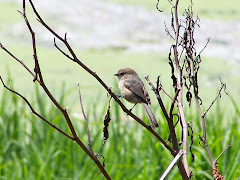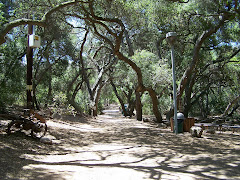My friend Gloria and I once walked under a Barn Owl Nest while bird watching at Turtle Rock Nature Center years ago. As we looked up, three downy owlets looked down at us. For quite a while we all gazed at each other. They were very cute and curious. For a birder, seeing an owl is always a wonderful treat. Especially during the daytime. With incredible eyesight and hearing, owls are very efficient nocturnal hunters. Out there in the dark night, they seem mysterious and fascinating.
 Barn Owl profile. Such a beautiful bird. This is a female Barn Owl from a South Bay Wildlife Rehab show at Wildbirds Unlimited, Huntington Beach in October of 2008. Her name is Miss Luna.
Barn Owl profile. Such a beautiful bird. This is a female Barn Owl from a South Bay Wildlife Rehab show at Wildbirds Unlimited, Huntington Beach in October of 2008. Her name is Miss Luna.Inhabiting all continents except Antarctica, Barn Owls are one of the most widespread owls in the World. They even inhabit large islands including Hawaii--although they were introduced there as rodent control. They are residents of Orange County. They are cavity nesters and adapt easily to buildings. Unconcerned about humans nearby, they have spread throughout the world nesting in barns and buildings. There have been reports of Barn Owls landing on ships offshore. They evidently will fly over the ocean to ships and islands.

Barn Owls have a heart-shaped white face rimmed with a brown ridge of feathers. Their unusual face has earned them the nicknames "Ghost Owl" and "Monkey-faced Owl." Its beautiful color is the reason for another nickname-- "The Golden Owl." They are brownish and white. Small brownish spots sprinkled all over the front and heavy metallic silver sprinkles on the back of the head, back, and wings. They do not hoot. They make hissing and screeching noise. It can be quite unnerving. Barn Owls have very long legs. Like other owls, they must turn their heads to look around. Their large eyes cannot move like ours do. The largest Barn Owl race is in the United States. Like many raptors, females are larger than the males.
 Notice the brown and silver speckles. Not many birds have this silver color.
Notice the brown and silver speckles. Not many birds have this silver color.Owls are nocturnal. Barn Owls are one of the most nocturnal owls we have. They hunt at night using their excellent hearing and sight. They hunt low over the ground seeking out small mammals--mainly rodents. They also eat reptiles, small birds, and sometimes fish and insects. One study found crayfish in Barn Owl pellets. Like other owls, they regurgitate the inedible parts like the bones, fur, feathers, etc. in a pellet that falls to the ground under their perch. Lots of pellets will tell a birder that an owl's favorite perch is overhead. Usually, it is only during nesting season will you see a Barn Owl out in twilight, but in some areas the Barn Owl is seen more frequently during the day or crepuscular times of day. Its specialized feathers--similar to other owls--give it an almost silent flight.

During three months, a family of Barn Owls can eat 1,000 rodents. A single Barn Owl can eat 2,000 rodents a year. Most of these are rats, mice, and gophers. Rabbits are too large for Barn Owls to take. Barn Owls fly close to the ground looking for prey. This can cause fatalities when the owls flying low in search of prey cross a street. Because Barn Owls kill and eat many rodents every year--especially while they are raising young--farmers, land owners, and members of city and county government are beginning to install Barn Owl nesting boxes on their property in trees, on poles, and in barns. Encouraging Barn Owls on one's property can greatly reduce rodent problems with little cost or effort by merely installing Barn Owl nestboxes. It eliminates pesticides and is a nice natural way to keep down the rodent population. Sources for Barn Owl nest boxes or plans are listed in the links at the end of this post.
Nesting season is from February through June with the most nesting occurring from March through May. Barn Owls may start house hunting as early as December or January, and so it is good to have your nestbox up and ready by then. Barn Owls mate for life. Life unfortunately for Barn Owls is short. Just about 2 years in the wild, but 18 or more years in captivity. Barn Owls are prolific and may nest two or more times a year.
Barn Owl Miss Luna with handler at South Bay Wildlife Rehab show at Wildbirds Unlimited, Huntington Beach in October of 2008.
Some populations in warm climates may mate year-round. The male brings the food to the female, and she prepares it and feeds it to the owlets. There are an average of 4-7 eggs laid in a nest. Owlets are covered with white down. The female makes the nest at the bottom of a cavity or nestbox by shredding regurgitated pellets and placing them on the floor of the nesting area. There are records of Barn Owls nesting in burrows in the absence of trees with cavities.
Notice the Heart-Shaped face and the well-defined facial disc.
The Great Horned Owl is a formidable predator of the Barn Owl. The Barn Owl is smaller than the Great Horned Owl. It is one of the biggest challenges when rehabilitators release birds into the wild. Rehabilitators have had some success with adding Barn Owlets to a nest and having a wild Barn Owl foster the owlets. There are some successful releases of Barn Owls. The dangers for rehabilitated Barn Owls is great and not all survive.

Stretching her wings. Miss Luna.
Barn Owls are considered by some to be spooky, but if you really look at them, they are incredibly beautiful and amazing creatures. From the carefully constructed white, facial disc with its beautiful brown border to the silver sprinkling over its feathers, it is hard to find a more beautiful owl. Wildlife rehabilitators and biologists testify to the sweet personality of this predator.

Birders should consider going on either owl banding trips or night "Owl Prowls" Check out Sea and Sage's field trips or Starr Ranch Audubon for opportunities. Also check out listings of field trips and activities in Orange County Wild. You may get lucky. Maybe you will actually see a Barn Owl! Have fun birding in Orange County--even at night!
OC Birder Girl Links
Great Horned Owl--Bubo virginianus
Red-Shouldered Hawk
Red-Tailed Hawk--Buteo jamaicensis
 Courtesy US Fish and Wildlife-- Barn Owl --Photographer CF Zeillemaker
Courtesy US Fish and Wildlife-- Barn Owl --Photographer CF ZeillemakerExternal Links and Resources
All About Birds: Barn Owl
Detailed article about one of the most widely distributed birds in the world.
Animal Diversity Web: Barn Owls
Very thorough article on Barn Owls.
Backyard Barnyard Owls
About the benefits of Barn Owls.
Barn Owl Headquarters
Site encouraging and advocating the green method of rodent control: Barn Owls.
Barn owls all too happy to be your rat catchers--Birds a natural and chemical-free way to control pests
From the San Francisco Chronicle, an article about the use of Barn Owls in Rodent control.
"A special program of the Lycoming Audubon Society in cooperation with the Pennsylvania Game Commission." Good advice about nestboxes and Barn Owls.
From the UK, a great site on Barn Owls.
Burrow Digging by Barn Owls
(Journal of Field Ornithology: Vol. 44, No. 1, Winter, 1973)
Cape Romain: Barn Owl nest box project
Free plans and pictures of how to build a simple nest box for Barn Owls.
Common Barn-Owls From Captive Propagation Found Nesting in the Wild
(Journal of Raptor Research: Vol. 21, No. 2, 1987)
COMMON BARN-OWL POPULATION DECLINE IN OHIO AND THE RELATIONSHIP TO AGRICULTURAL TRENDS
(Journal of Field Ornithology: Vol. 56, No. 3, Summer, 1985)
COMPOSITION AND SEASONAL VARIATION OF THE BARN OWL "TYTO ALBA" DIET IN ARIZONA
(Journal of Raptor Research: Vol. 16, No. 2, 1982)
Continuous Nesting of Barn Owls in Illinois
(Wilson Bulletin: Vol. 111, No. 4, October-December, 1999)
Desert USA: The Common Barn Owl
Good article on the Barn Owl.
eHow: How to Build a Barn Owl Nesting Box
Step by step how to build a Barn Owl nesting box.
Farmers, Conservationists Seek Return of Barn Owls
The value of Barn Owls in pest reduction and reduced costs.
Food-niche Relationships Between Great Horned Owls and Common Barn-Owls in Eastern Washington
(Auk: Vol. 101, No. 1, January-March, 1984)
Growers find barn owls protect their crops
CCN article on how Barn Owls protect crops and save money.
Habitat for Hooters
Napa County Program.
The Hungry Owl Project
Good information from the Hungry Owl Project based in San Anselmo, CA.
The Internet Bird Collection: Common Barn Owl
High quality videos of Barn Owls.
National Geographic Barn Owl Coloring Page
For kids. Color a Barn Owl.
The Oregon Zoo: The Barn Owl
Detailed Article about Barn Owls from our neighbors up north.
Over-water Flights of Barn Owls
(Journal of Field Ornithology: Vol. 50, No. 1, Winter, 1979)
The Owl Cam: Frieda and Diego
Barn Owls Frieda and Diego's home is an online Barn Owl nestbox.
The Owl Pages: The Barn Owl
Article about the Barn Owl.
Owl Research Institute
Great organization located in Montana that does research on owls of all kinds. Great newsletter. Owl Id guide under construction.
Peregrine Fund: Barn Owls
Nice article.
The Progressive Farmer: Barn Owl Nesting Box Plan
Simple plan for making a Barn Owl Nesting Box. Plan only, you have to buy the wood. They charge for the plan. Interesting that the farmers are beginning to see the value in natural and cheap rodent control.
The Proof is in the Pellet
Audubon Magazine article on how Barn Owls can be used to reduce mice, rat, and other rodents and save money for homeowners, cities, farmers and more by providing free pest removal.
SUCCESSFUL RELEASES OF CAPTIVE BARN OWLS
(Journal of Raptor Research: Vol. 14, No. 2, 1980)
Summary of California studies analyzing the diet of barn owls.
Good diet info.
Wesley the Owl
Story of the relationship between a rescued baby Barn Owl and a biologist.
WildWathCams: The Barn Owl Cam Story
Owl Cam in Washington State.
USGS: Barn Owl
Good article on the Barn Owl.
Home - Index - Contact - Shop - Ask the OC Birder Girl -OC Birder Girl Videos





 Barn Swallow on pipe. Notice the deeply forked tail. Easy to spot in flight.
Barn Swallow on pipe. Notice the deeply forked tail. Easy to spot in flight.
 Barn Swallow singing on the No-Fishing Sign.
Barn Swallow singing on the No-Fishing Sign.
 Cliff Swallow Nest for comparison--enclosed with a tunnel to the nest. Picture taken at the Lion Enclosure at the San Diego Wild Animal Park.
Cliff Swallow Nest for comparison--enclosed with a tunnel to the nest. Picture taken at the Lion Enclosure at the San Diego Wild Animal Park.

 Barn Swallows. Notice the short, wide beak, perfect for gathering insects as it swoops through the air.
Barn Swallows. Notice the short, wide beak, perfect for gathering insects as it swoops through the air.







